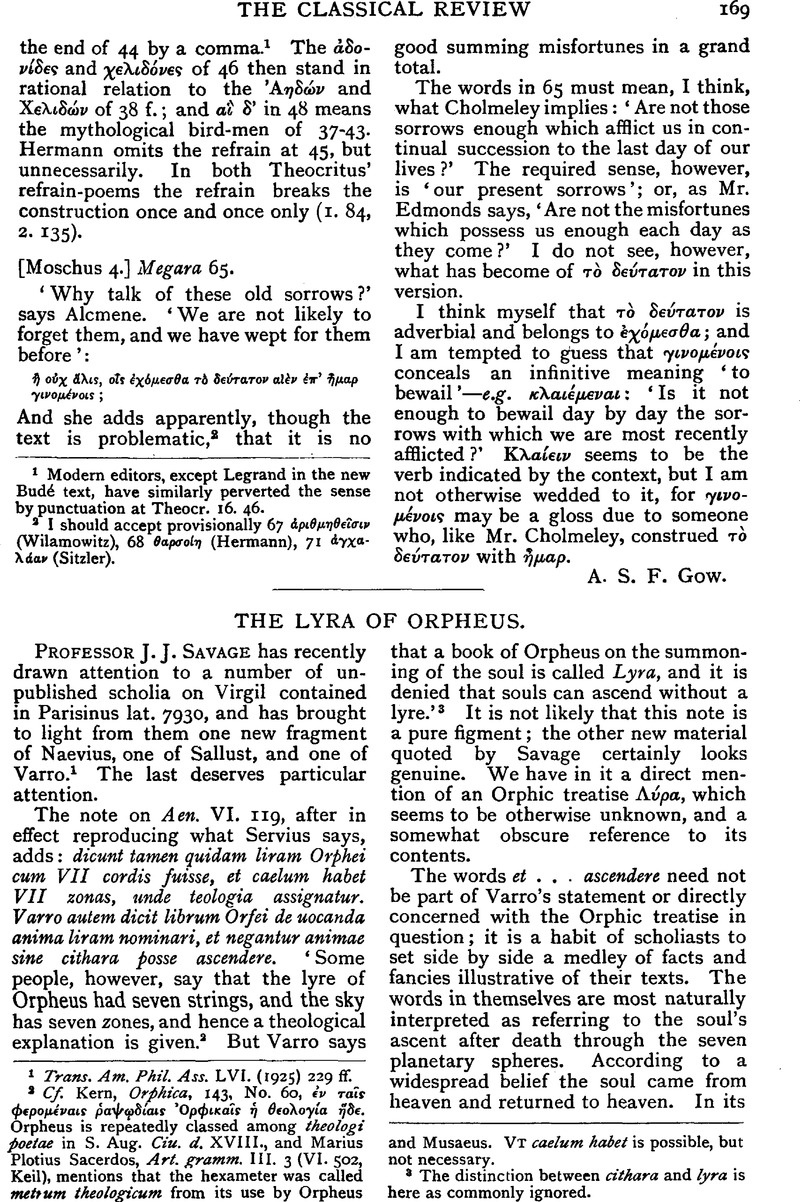
page 169 note 1 Trans. Am. Phil. Ass. LVI. (1925) 229 ff.Google Scholar
page 169 note 2 Cf. Kern, Orphica, 143, No. 60, ν ταῖς φερομναις ῥαψῳδαις Ὀρφικαῖς θεολογα ἥδε. Orpheus is repeatedly classed among theologi poetae in S. Aug. Ciu. d. XVIII., and Marius Plotius Sacerdos, Art. gramm. III. 3 (VI. 502, Keil), mentions that the hexameter was called metrum theologicum from its use by Orpheus and Musaeus. Vt caelum habet is possible, but not necessary.
page 169 note 3 The distinction between cithara and lyra is here as commonly ignored.
page 170 note 1 Serv. ad Aen. VI. 714; cf. his note on XI. 50 and Arnob. II. 16, 28 (both perhaps drawing upon Labeo), and Macrob. In Somn. Scip. I. 11. 12 (drawing on Numenius, according to Cumont, , Revue de philologie, 1920, 231Google Scholar). On the idea in general cf. Bousset, , Arch. f. Rel. XVIII. 145 ff.Google Scholar
page 170 note 2 Corp. Herm. I. 25. The first zone is the Moon's. The qualities lost at the later spheres are sins.
page 170 note 3 For the voices of the planets cf. Cumont, , Rev. phil. 1919, 78 ff.Google Scholar; for the cathartic power of music, Delatte, A., Étude sur la littérature pythagoricienne, 262 f.Google Scholar; for the lyre's harmony as an imitation of the harmony of the universe, Serv. in Aen. VI. 645 and Cumont, , Rev. arch. 1918, 67Google Scholar. Hippolytus, Ref. IV. 48. 2, p. 70. 20 Wendland remarks that the constellation Lyra has seven strings signifying the whole harmony of the universe.
page 170 note 4 A possible parallel is the representation in the stuccos of the apse of the Basilica near the Porta Maggiore of Sappho holding a lyre as a type of the blessed soul (cf. now Carcopino, J., Études Romaines, I. 372 ff.Google Scholar).
page 170 note 5 Diehl, Inscr. chr. lat. 1644, 3359.
page 170 note 6 P. Oxy. 412. Cf. on it Hopfner, Th., Griechisch-ägyptischer Offenbarungszauber, II. 150 ff.Google Scholar, §§ 334 ff.; Hopfner gives a full treatment of the whole subject.
page 170 note 7 In Vatinium 14 (cum means ‘though’ in reference to words here omitted). For Varro's interest in thaumaturgy cf. Apul. Apol. 42 (his record of a prophecy about the result of the Mithridatic war made by a boy of Tralles who looked at a reflection of a Hermes in water).